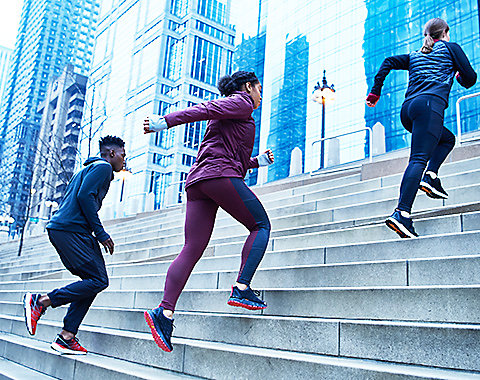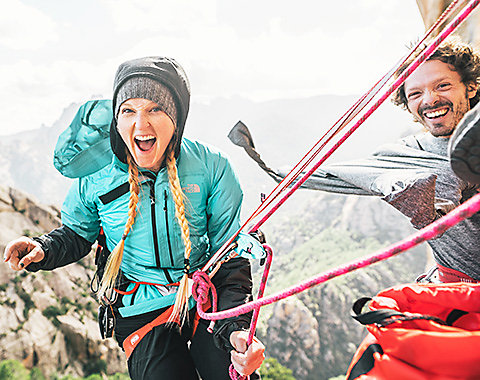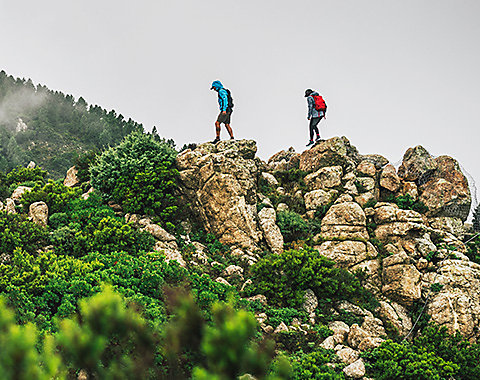Caroline Ciavaldini grew up sport climbing in lush tropical surroundings in her native La Réunion, an island in the Indian Ocean. She spent her teens and early twenties competing and was highly successful finishing third in the Lead World Cup in 2005 and 2006 and dominating the French Lead Championships from 2004 to 2007. But by the age of 26 she wanted more. She swapped competition for high alpine adventures and one of those adventures took her to Grand Capucin, a towering, lofty granite pinnacle on the Mont Blanc Massif at an altitude of 3,500m. She set her sights on the 450m-long Voie Petit route, maxing at 8b. This is her story, in her words.

Photo: Francisco Taranto
Why had I set my eyes on an objective I had none of the skills for? I had no alpine experience whatsoever. No knowledge of granite rock. No endurance in general.
The Voie Petit route is the creation of Arnaud Petit, a spectacular climber - a world cup winner and a mountain guide. A man who succeeded in reconciling two worlds that often look down on one another: rock climbing and alpinism. Arnaud and his partner, Stephaine Bodet were the sparks that lit my fire: having them as role models it was just a matter of looking at their routes. And so I did, and there it was, a dream in the air: the Voie Petit.
I'd been competing for 10 years in the climbing lead world cups. I'd won and made podiums. But there is a world between an eight minute exercise on artificial walls and free climbing a vertical or overhanging wall of granite above a glacier.
So when I finally decided on the route, I made a plan: I had to learn all the skills that I missed. And the list was long, from walking on ice with crampons to climbing very, very far above your last protection with the knowledge that injury would be the likely result of a fall.
I trained for a full year with my goal in my mind every morning when I woke up. I had set myself a few rules, because big wall climbing is full of shades of grey and you are the only one who can decide on limits. I could count on my indefectible partner, James Pearson, my husband and best climbing partner, to support me and belay me. But it was my project and I would be the only one to recognise the movements of the route and place the rope in dangerous sections. I wouldn’t use an easier route on the left or on the right to shortcut the recognition phase. I would climb only in the route, by my own abilities. Quite simply, I'd go from the bottom to the top and if I couldn't pass a section, I couldn't go up!
In total, I went to the route four times before climbing the whole thing to learn the movements of every pitch. At the beginning, it seemed like I was on the moon. But I trained hard and I trained right. Most of all, I'd done a lot of mental preparation, reusing all the things I'd learned over my competition years. Visualisation gave me a pool of energy to dig from on D-Day and I was handling the fear of danger like I used to handle the fear of failing in competitions.
I did rely on someone I trust entirely for all the areas where James and I are only beginners: weather, security on the glacier and altitude management are all the skills of Marion Poitevin, a young mountain guide and instructor for mountain guide aspirants. I counted on her for advice, just like I counted on Arnaud and Stephanie Bodet for the route’s specifics. But, more than that, they pushed me because they deeply wanted me to succeed.

Photo: Francisco Taranto

Photo: Dark Sky Media
On my final scouting trip, Marion called me to tell me there was a weather window. I had been planning on simply going to the route to check out the last 150m that I hadn’t reached yet and stopping and using the ropes that I had placed on the lower parts of the route. But Arnaud called me and suggested I give it a serious try on the first part, and then sleep on the Bonatti Ledge at two-thirds of the way up and to free climb the last pitches on the second day.
Marion came with us and as we had much bigger bags for the bivouac on the wall, she helped James manage all the logistics of hauling the bags up. I only had to lead, they would follow me.
I reached the crux pitch, the 8b, and focused simply on trying. It was an exhausting battle on that pitch, I nearly blacked out on reaching the belay, a combination of effort and altitude, but I did it. I succeeded on the hardest pitch, so I had a chance of reaching the top.
To succeed on a multi-pitch route you have to free climb each pitch in one push. So at that point, I still had eight pitches to go. But I felt all the motivation from my year of training pushing me up, and after two more pitches (7c+ then 7b+), I reached the ledge.
I had never slept on a ledge and was looking forward to the experience: you haul up bags with sleeping bags and mats, down jackets, a stove to melt the snow that remains on the ledge and cook your dehydrated dinner. You sleep with your harness on, on a tiny 80cm wide ledge with 400m of air below you. If you slip, a rope will save you. What you can’t stop looking at is the mountain panorama all around you.

Photo: Francisco Taranto

Photo: Dark Sky Media
To say that I slept wonderfully would be exaggerated, but I'd made the most of my night to visualise the second part, trying to imagine struggling on the 8a pitch, the hardest of the top part. It had a reputation for being very technical and hard to figure out.
After a 6am start on an easier pitch, I'd made it to the beginning of the 8a. It looked beautiful. Yes, it was technical, but I was patient. I figured out each move first then I began to climb. I was focused and mistakes didn’t matter because there was this enormous bubble of motivation behind me. There were only a few easier pitches and a 7b+ between me and success, and part of me knew at that point that I had it. But I focused on every movement one after the other. I had to redo the 7b+ twice to complete it and reach the summit. But that was it. I'd done it. My big one-year dream became reality.
But I didn’t let the joy explode. After 450m of climbing we still had to abseil. The three of us were happy and in complete harmony but we knew we still had to remain focused. Abseiling is the last page of a climbing story, but it has to be finished smoothly to make a happy end – when you are tired, mistakes can happen all too easily.
We reached the bottom of the face, walked back to the telepherique lift but we had to wait an entire night in the refuge before finally getting back down to the valley. I'd done it, with James and Marion and Arnaud and Steph and all the people who deeply wished me to succeed.
I'd taken so many "little adventures" as part of that big adventure. I'd learned granite climbing in La Pedriza. I'd trained my mental strength on daring English trad routes. I'd spent many hours in my home gym holding onto one more hold just one more second because it is the sum of all little things that would, and did, make the difference. I did it. And it will always be there as my most daring project, transformed into a success with all these people pushing me.

Photo: Francisco Taranto

Photo: Dark Sky Media




